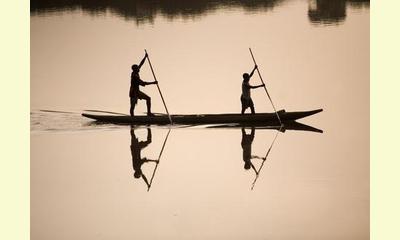|
|
World Heritage Site a Haven for African Wildlife
un article par Sudan Vision
A massive swath of lush forest that straddles the borders of three African nations and is home to crowds of elephants, gorillas, chimpanzees and other wildlife has been declared a World Heritage Site. The 9,700-square-mile (25,000-square-kilometer) site, known as the Sangha Tri-National Protected Area, or TNS, covers territory in the Republic of Congo (Brazzaville), Cameroon and the Central African Republic.

Pygmy, Sangha Trinational © Raulf Fisher (UNESCO WHC)
click on photo to enlarge
The announcement of the designation came during the annual meeting of the United Nations World Heritage Committee, held in St. Petersburg, Russia, this year.
The site is the first to span three countries, and stitches together previously established national parks. The protected area encompasses one of the most pristine regions of equatorial Africa. The park is home to tropical forests, wetlands and natural clearings — known as "bais" — that draw enormous gatherings of some of the region's most iconic animals.
Elephant crowds of more than 100 strong congregate in the bais, alongside forest buffalo and giant forest hogs. Some of the bais attract huge groups of gorillas, while others attract flurries of parrots.
The heart of the TNS is an area nearly 3,000 square miles (7,700 square km) across, which follows the course of the Sangha River, a tributary of the far larger Congo River. Surrounding the core of the park is a vast buffer zone, home to groups of indigenous peoples, and regions where some controlled logging is permitted.
Conservation groups have lauded the designation. "The TNS is the wild heart of the Congo Basin Rainforest. It contains some of the last great populations of African forest elephants, gorillas, chimpanzees, and other endangered species," James Deutsch, the Wildlife Conservation Society's director of Africa Programs, said in a statement.
"As everywhere in Central Africa, this global treasure is under threat from unsustainable resource extraction, including the illegal ivory trade, and we hope that the TNS's listing will re-energize global efforts to save it," Deutsch said.
The World Heritage Committee announced the establishment of 26 new sites around the globe during their meeting this year
|








|
DISCUSSION
Question(s) liée(s) à cet article:
What is the relation between the environment and peace?,
* * * * *
Commentaire le plus récent:
[quote=mmartin,Nov. 16 2004,22:16][/quote]
| Quote | | Preserve the planet is one of the keys of a culture of peace. |
For sure it is; the question is what is the relation, and for this we can best listen to the wisdom of so many indigenous peoples, that from times immemorial are guardians of the earth. If we are not at peace with our environment, behaving like parasites, how can we even think about a peacefull and non violent culture for our future generations....it is like a contradiction in terms.
So we have to heal this error of thinking and realise that the relation between the environment and peace is one of inextricable boundage.
This is why I want to bring under your attention the Global Campaign: SPEAKING4EARTH that is launched at 9 december 2004 in the Peace palace in The Hague.
Indigenous peoples have a deep spiritual connection to their land, including the sky, the clouds, the rivers, the soil and all living creatures. In the indigenous world, it is said that land is not something you inherit from your ancestors, but rather something you borrow from your children. Speaking4Earth is a project connecting this sense of change in the western relationship with the world with the vision of indigenous peoples that we need to care for the earth for our future generations. Speaking4 earth makes it priority to have the draft declaration on the Collective Rights of Indigenous Peoples addopted by the GA of the UN
reading their website:
For twenty years, Indigenous Peoples and their support organisations have been pressuring the United Nations to adopt a declaration for the protection of the rights of the world’s Indigenous Peoples. It is feared that – due to blocking attempts most notably by the UK and the USA - the UN will now stop this process and leave Indigenous Peoples’ rights unrecognized. . ... continuation.

|
|









